CHEVROLET CAMARO 1982 Repair Guide
Manufacturer: CHEVROLET, Model Year: 1982, Model line: CAMARO, Model: CHEVROLET CAMARO 1982Pages: 875, PDF Size: 88.64 MB
Page 761 of 875

GM – CAMARO 1982-1992 – Repair Guide (Checked by WxMax) 761
MAINTENANCE OR REPAIR?
Maintenance includes routine inspecti
ons, adjustments, and replacement of
parts which show signs of normal wear . Maintenance compensates for wear or
deterioration. Repair implies that someth ing has broken or is not working. A
need for a repair is often caused by lack of maintenance. for example: draining
and refilling automatic transmission fl uid is maintenance recommended at
specific intervals. Failure to do this can shorten the life of the
transmission/transaxle, requiring very expen sive repairs. While no maintenance
program can prevent items from eventually breaking or wearing out, a general
rule is true: MAINTENANCE IS CHEAPER THAN REPAIR.
Two basic mechanic's rules should be mentioned here. First, whenever the left
side of the vehicle or engine is refe rred to, it means the driver's side.
Conversely, the right side of the vehi cle means the passenger's side. Second,
screws and bolts are removed by turn ing counterclockwise, and tightened by
turning clockwise unless specifically noted.
Safety is always the most important rule. Constantly be aware of the dangers
involved in working on an automobile and take the proper precautions. Please
refer to the information in this se ction regarding SERVICING YOUR VEHICLE
SAFELY and the SAFETY NOTICE on the acknowledgment page.
AVOIDING THE MOST COMMON MISTAKES
Pay attention to the instructions prov ided. There are 3 common mistakes in
mechanical work:
1. Incorrect order of assembly, di sassembly or adjustment. When taking
something apart or putting it toget her, performing steps in the wrong
order usually just costs you ex tra time; however, it CAN break
something. Read the entire proc edure before beginning. Perform
everything in the order in which the instructions say you should, even if
you can't see a reason for it. When you' re taking apart something that is
very intricate, you might want to draw a picture of how it looks when
assembled in order to make sure you get everything back in its proper
position. When making adjustments, per form them in the proper order.
One adjustment possibly will affect another.
2. Overtorquing (or undertorquing). While it is more common for overtorquing to cause damage, undertorquing may allow a fastener to
vibrate loose causing serious dam age. Especially when dealing with
aluminum parts, pay attention to tor que specifications and utilize a torque
wrench in assembly. If a torque figure is not available, remember that if
you are using the right tool to perfo rm the job, you will probably not have
to strain yourself to get a fast ener tight enough. The pitch of most
threads is so slight that the te nsion you put on the wrench will be
multiplied many times in actual fo rce on what you are tightening.
There are many commercial products avai lable for ensuring that fasteners won't
come loose, even if they are not torqued just right (a very common brand is
Page 762 of 875

GM – CAMARO 1982-1992 – Repair Guide (Checked by WxMax) 762
Loctite). If you're worried about getting so
mething together tight enough to hold,
but loose enough to avoid mechanical damage during assembly, one of these
products might offer substantial insurance. Before choosing a threadlocking
compound, read the label on the pa ckage and make sure the product is
compatible with the materials, fluids, etc. involved.
3. Crossthreading. This occu rs when a part such as a bolt is screwed into a
nut or casting at the wrong angle and forced. Cr ossthreading is more
likely to occur if access is diffic ult. It helps to clean and lubricate
fasteners, then to start threading the bolt, spark pl ug, etc. with your
fingers. If you encounter resistance, unscrew the part and start over
again at a different angle until it can be inserted and turned several t\
imes
without much effort. Keep in mind t hat many parts have tapered threads,
so that gentle turning will automatica lly bring the part you're threading to
the proper angle. Don't put a wrench on the part until it's been tightened
a couple of turns by hand. If you s uddenly encounter resistance, and the
part has not seated fully, don't force it. Pull it back out to make sure it's
clean and threading properly.
Be sure to take your time and be pati ent, and always plan ahead. Allow yourself
ample time to perform r epairs and maintenance.
TOOLS AND EQUIPMENT
Without the proper tools and equipment it is impossible to properly service your
vehicle. It would be virtually impossible to catalog every tool that you would
need to perform all of the oper ations in this repair guide. It would be unwise for
the amateur to rush out and buy an expens ive set of tools on the theory that
he/she may need one or more of them at some time.
The best approach is to proceed slowly, gathering a good quality set of those
tools that are used most frequently. Don't be misled by the low cost of bargain
tools. It is far better to spend a little more for better quality. Forged wrenches, 6
or 12-point sockets and fine tooth ratc hets are by far preferable to their less
expensive counterparts. As any good me chanic can tell you, there are few
worse experiences than trying to work on a vehicle with bad tools. Your
monetary savings will be far outweighed by frustration and mangled knuckles.
Begin accumulating those tools that are used most frequently: those associated
with routine maintenance and tune-up. In addition to the normal assortment of
screwdrivers and pliers, you should have the following tools:
• Wrenches/sockets and combination o pen end/box end wrenches in sizes 1/83/4 in. and/or 3mm-19mm 13/16 in. or 5/8 in. spark plug socket
(depending on plug type).
If possible, buy various length socket drive extensions. Universal-joint\
and
wobble extensions can be extremely usef ul, but be careful when using them, as
they can change the amount of torque applied to the socket.
Page 763 of 875
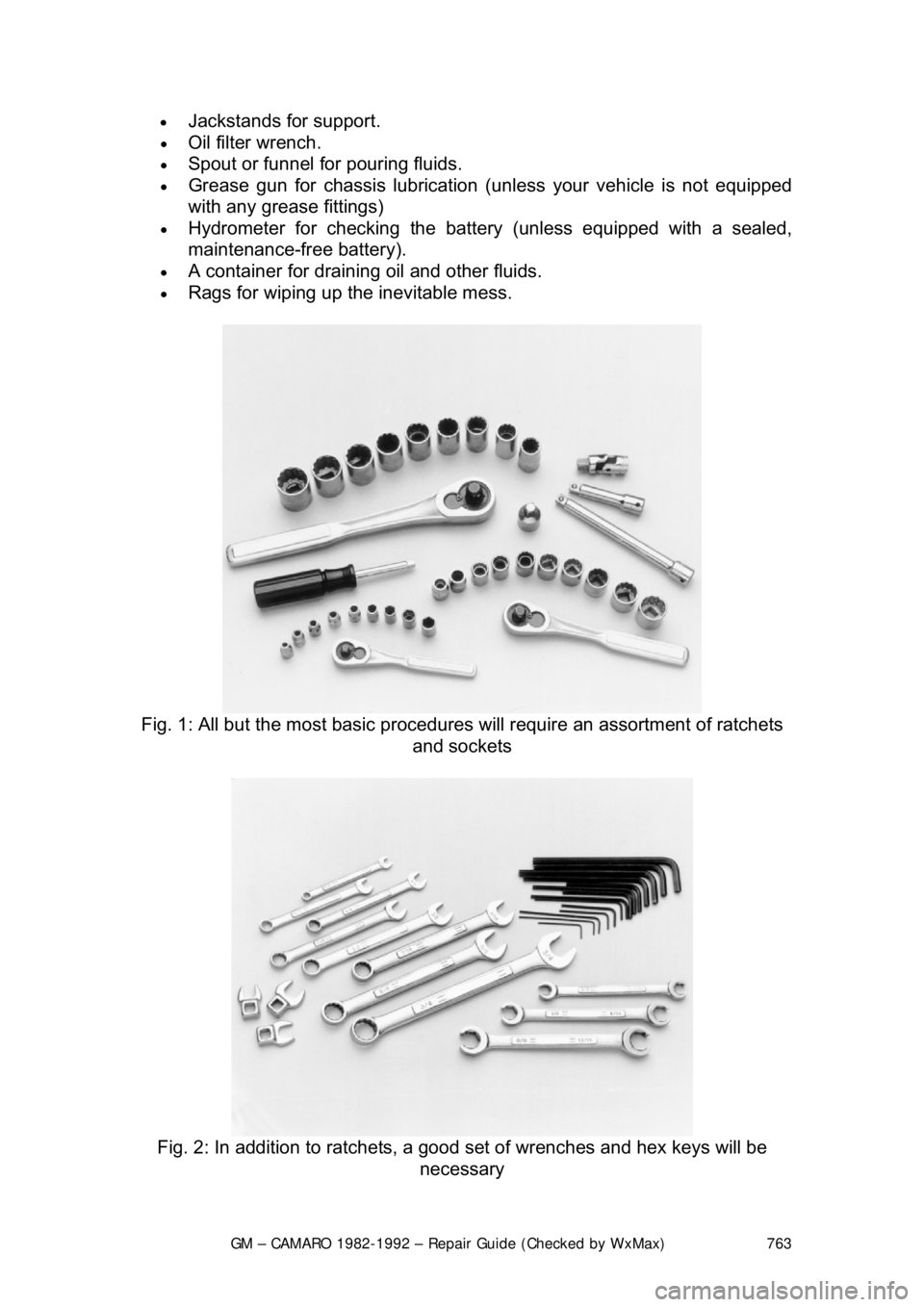
GM – CAMARO 1982-1992 – Repair Guide (Checked by WxMax) 763
•
Jackstands for support.
• Oil filter wrench.
• Spout or funnel for pouring fluids.
• Grease gun for chassis lubrication (unl ess your vehicle is not equipped
with any grease fittings)
• Hydrometer for checking the battery (unless equipped with a sealed,
maintenance-free battery).
• A container for draining oil and other fluids.
• Rags for wiping up the inevitable mess.
Fig. 1: All but the most basic procedures will require an assortment of ratchets
and sockets
Fig. 2: In addition to ratchets, a good set of wrenches and hex keys will be
necessary
Page 764 of 875
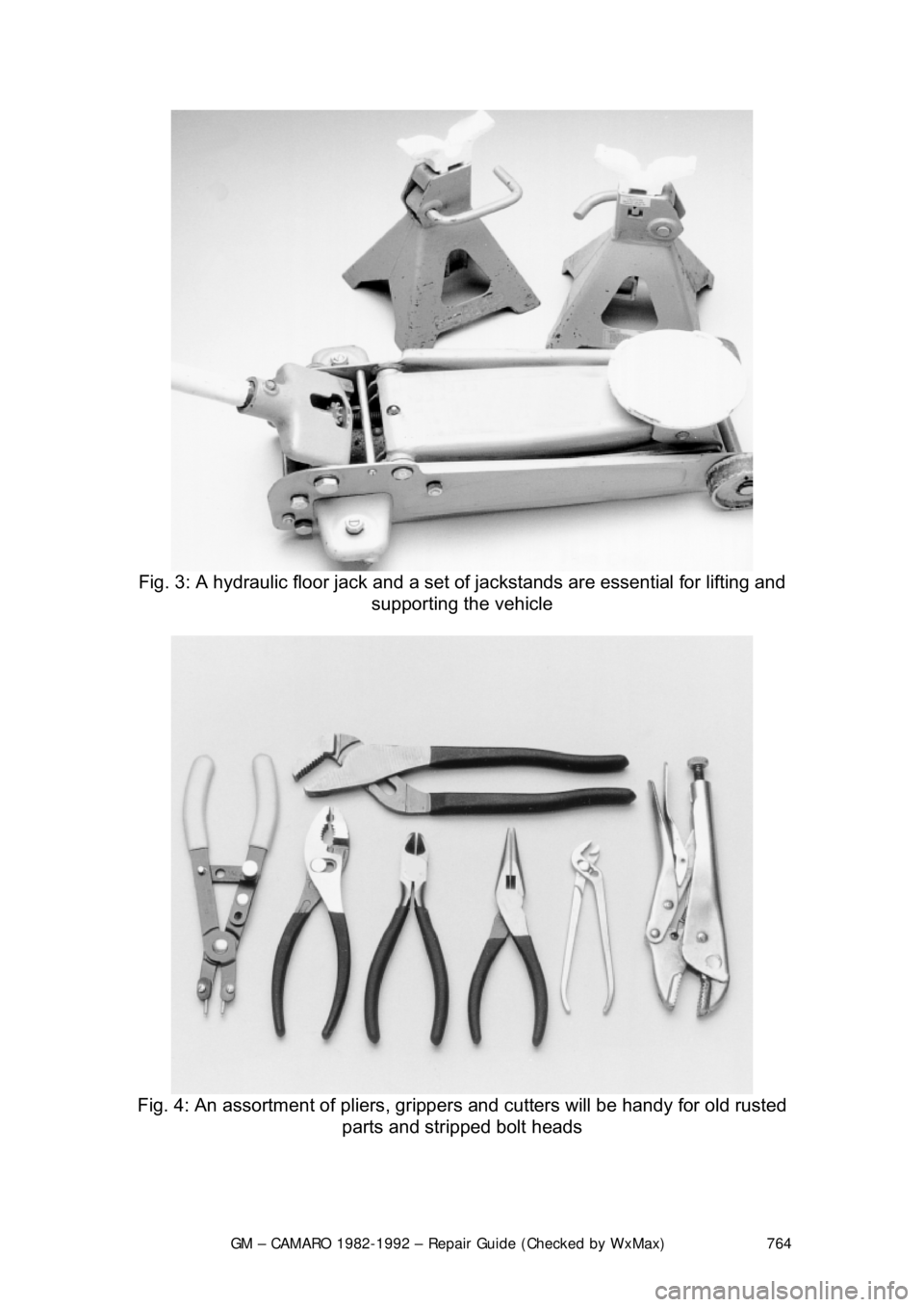
GM – CAMARO 1982-1992 – Repair Guide (Checked by WxMax) 764
Fig. 3: A hydraulic floor jack and a set of jackstands are essential for lifting and
supporting the vehicle
Fig. 4: An assortment of pliers, gr ippers and cutters will be handy for old rusted
parts and stripped bolt heads
Page 765 of 875
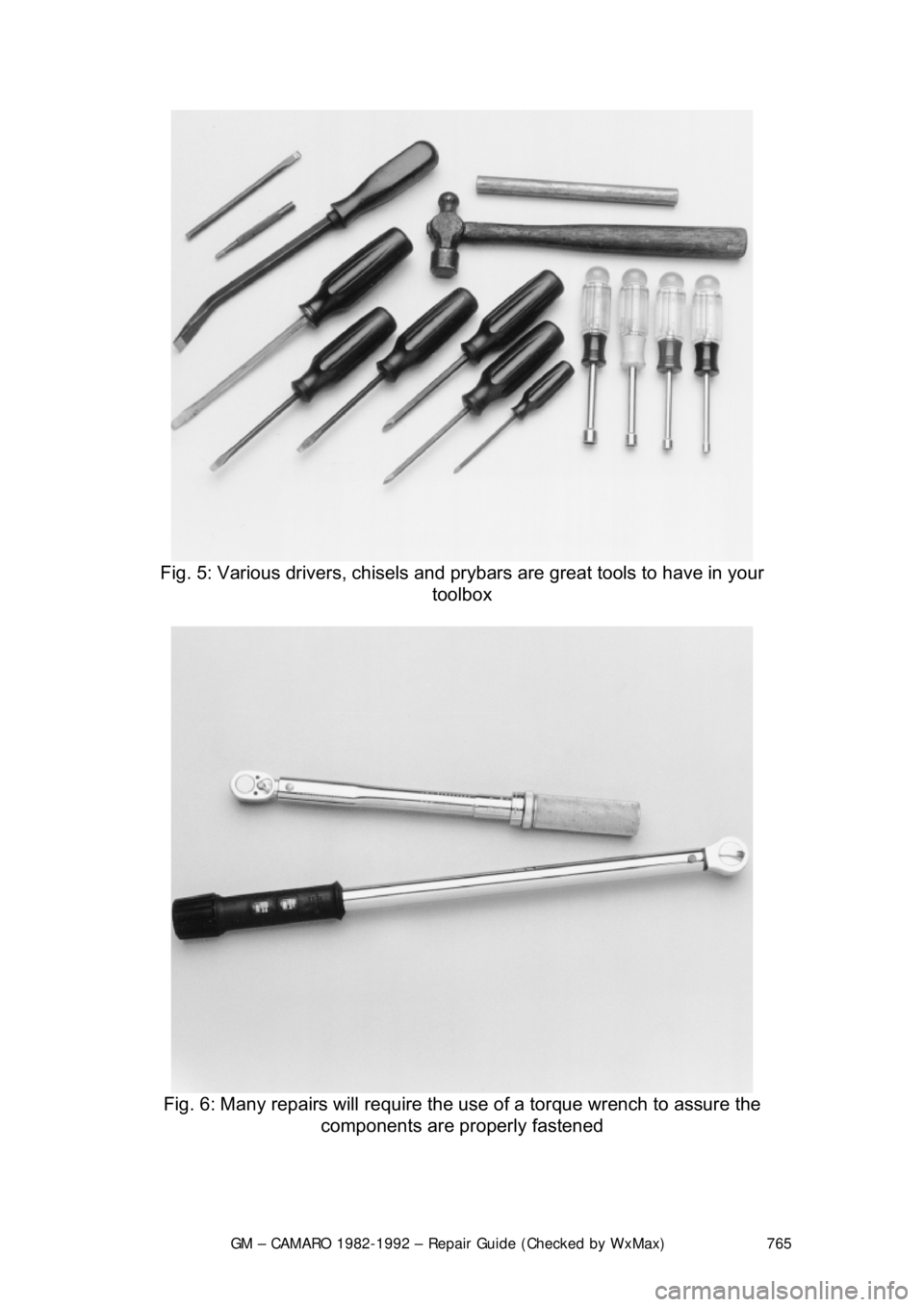
GM – CAMARO 1982-1992 – Repair Guide (Checked by WxMax) 765
Fig. 5: Various drivers, chisels and pr ybars are great tools to have in your
toolbox
Fig. 6: Many repairs will require the us e of a torque wrench to assure the
components are properly fastened
Page 766 of 875
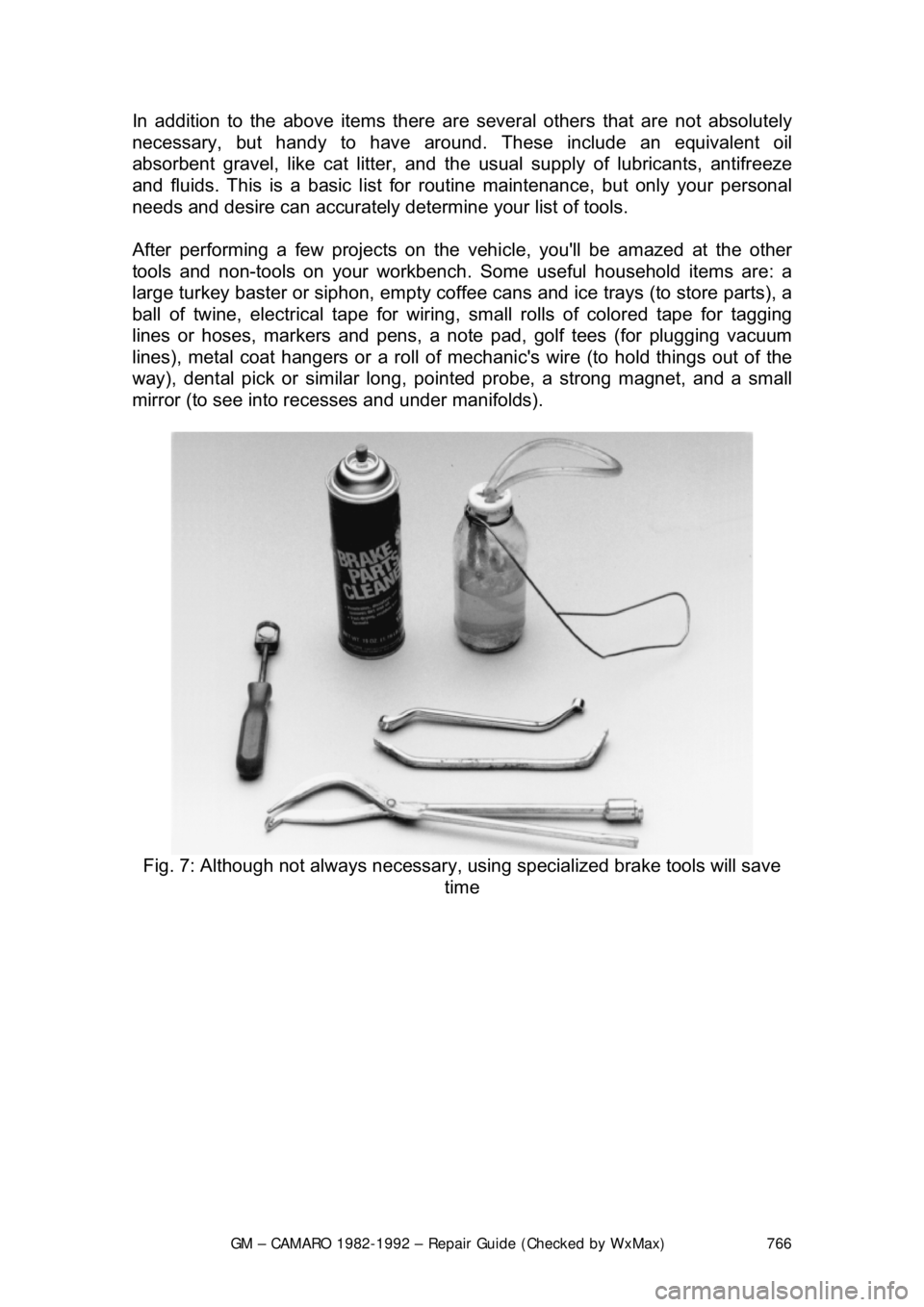
GM – CAMARO 1982-1992 – Repair Guide (Checked by WxMax) 766
In addition to the above it
ems there are several others that are not absolutely
necessary, but handy to have around. These include an equivalent oil
absorbent gravel, like cat litter, and the usual supply of lubricants, antifreeze
and fluids. This is a basic list for rout ine maintenance, but only your personal
needs and desire can accurately determine your list of tools.
After performing a few projects on the vehi cle, you'll be amazed at the other
tools and non-tools on your workbench. Some useful household items are: a
large turkey baster or siphon, empty coff ee cans and ice trays (to store parts), a
ball of twine, electrical t ape for wiring, small rolls of colored tape for tagging
lines or hoses, markers and pens, a note pad, golf tees (for plugging vacuum
lines), metal coat hangers or a roll of mechanic's wire (to hold things out of the
way), dental pick or similar long, poi nted probe, a strong magnet, and a small
mirror (to see into rece sses and under manifolds).
Fig. 7: Although not always necessary, us ing specialized brake tools will save
time
Page 767 of 875
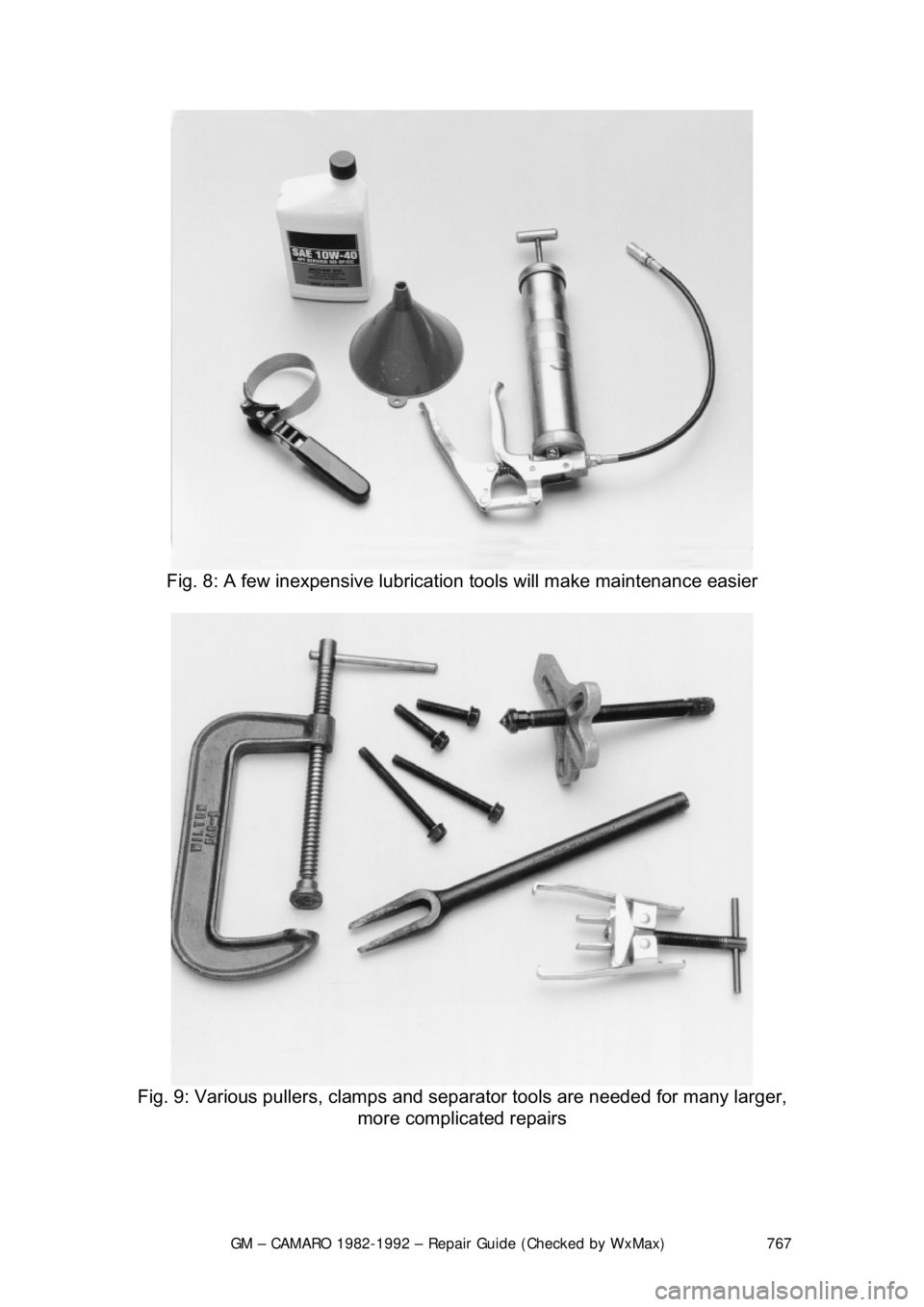
GM – CAMARO 1982-1992 – Repair Guide (Checked by WxMax) 767
Fig. 8: A few inexpensive lubricati on tools will make maintenance easier
Fig. 9: Various pullers, clamps and separ ator tools are needed for many larger,
more complicated repairs
Page 768 of 875
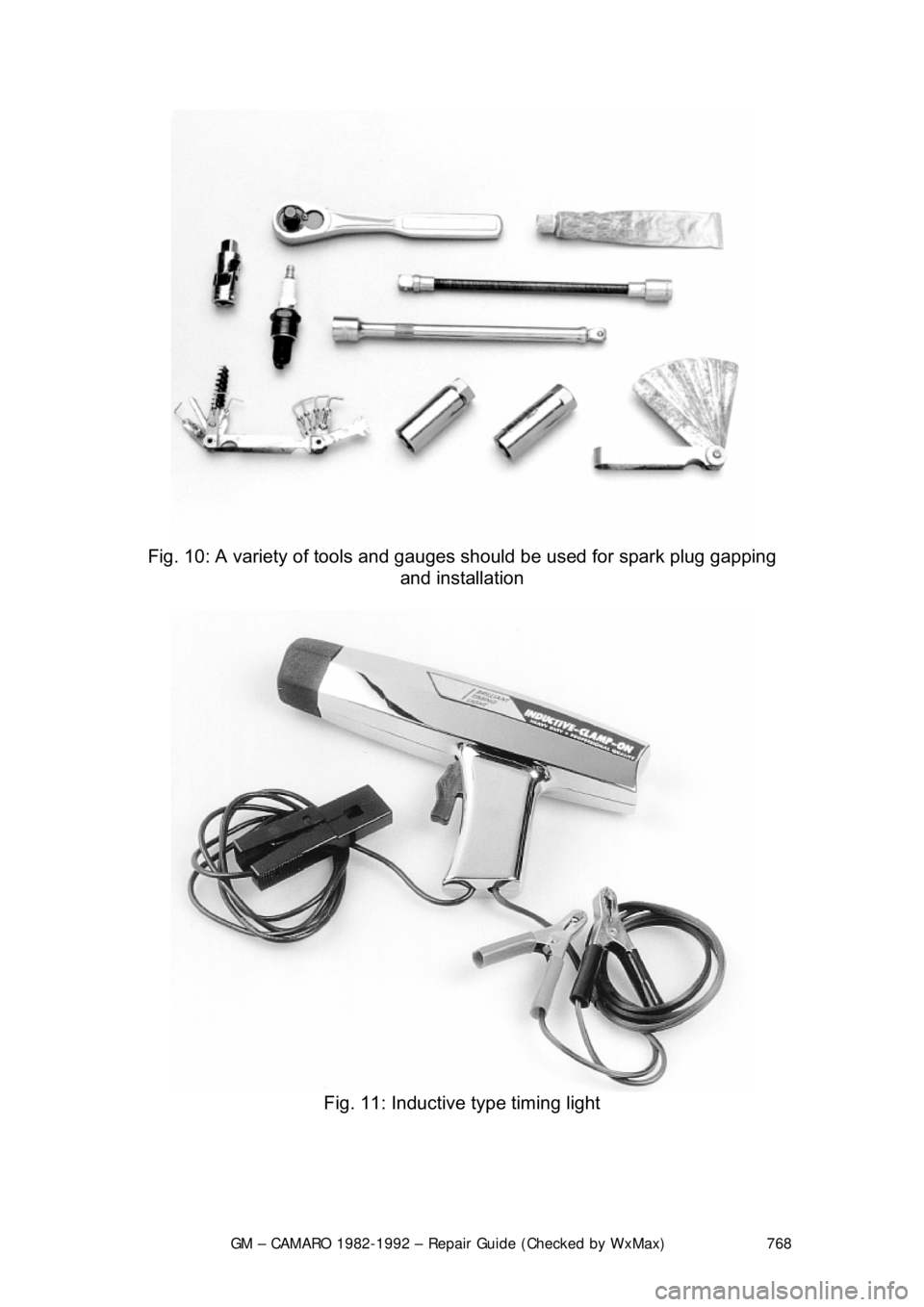
GM – CAMARO 1982-1992 – Repair Guide (Checked by WxMax) 768
Fig. 10: A variety of tools and gauges should be used for spark plug gapping
and installation
Fig. 11: Inductive type timing light
Page 769 of 875
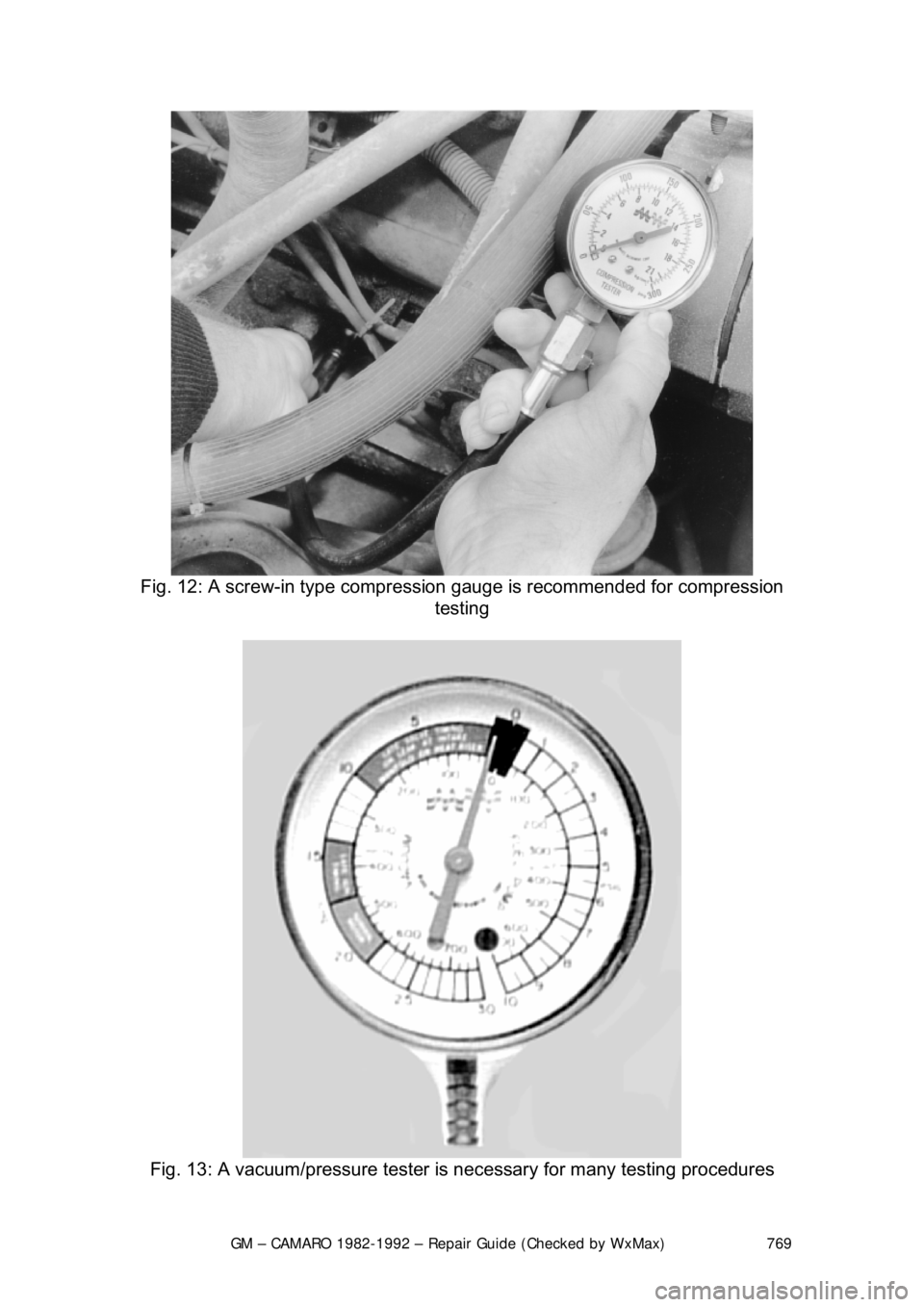
GM – CAMARO 1982-1992 – Repair Guide (Checked by WxMax) 769
Fig. 12: A screw-in type compressi on gauge is recommended for compression
testing
Fig. 13: A vacuum/pressure tester is necessary for many testing procedur\
es
Page 770 of 875
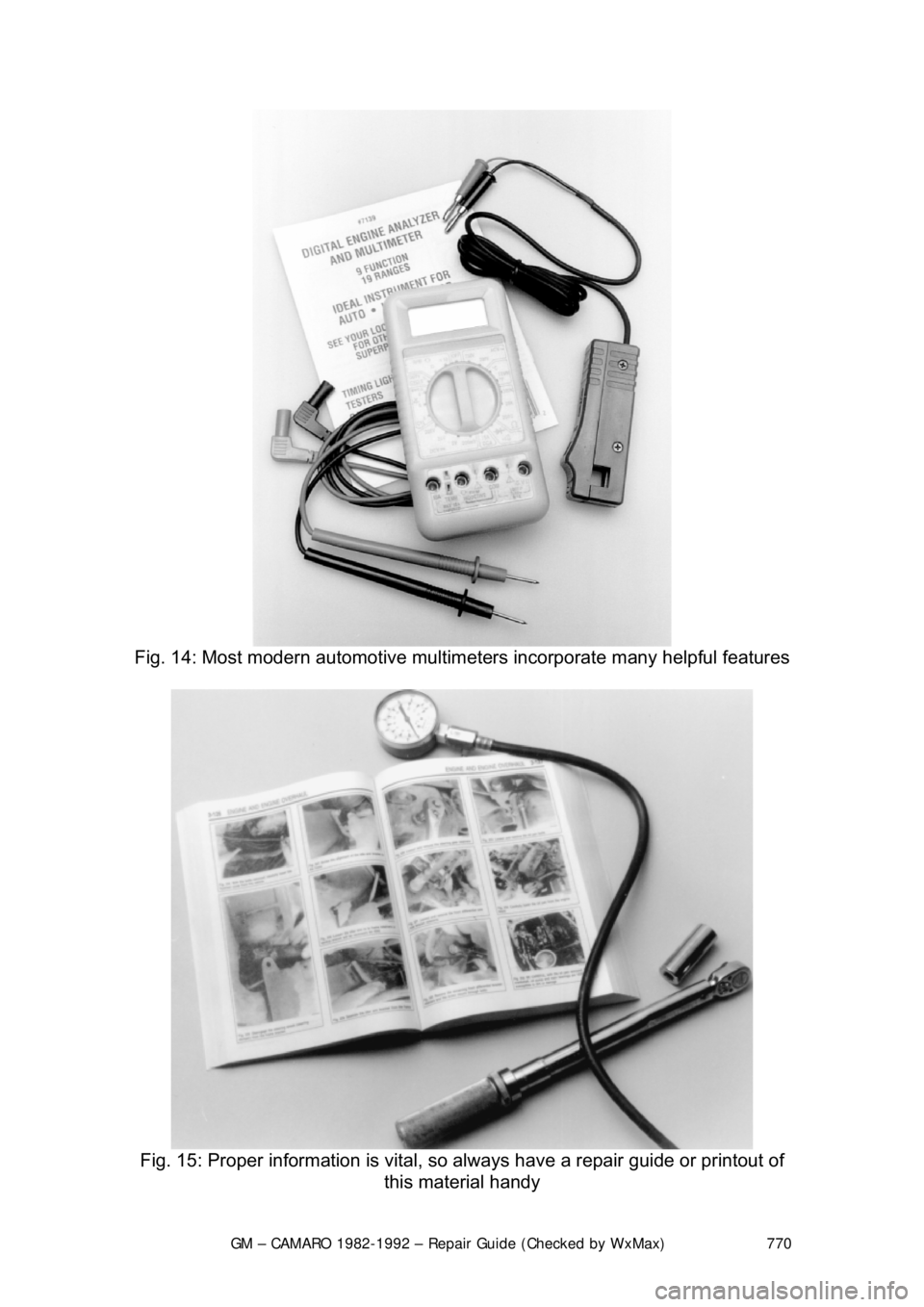
GM – CAMARO 1982-1992 – Repair Guide (Checked by WxMax) 770
Fig. 14: Most modern automot ive multimeters incorporate many helpful features
Fig. 15: Proper information is vital, so always have a repair guide or printout of
this material handy